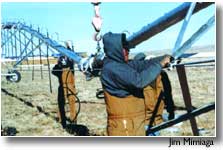|
Dec. 21, 2000 By Jim Mimiaga
Tuesday’s ceremony marking the completion of 110 center-pivot sprinklers on the Ute Mountain Ute reservation was distinctly casual, with local dignitaries mingling with jocular workers against a backdrop of circle farms and distant desert mountains. Yet the occasion was at the same time momentous — a symbol of American Indian independence, and a testament to the success tribes can enjoy when they take charge of their own destinies. "This is an extremely proud day for not only Utes, but for all Indian communities," said Ute Mountain Chairman Ernest House shortly before the last structure was assembled by several of the 15 Utes employed with the operation. "Water is our economic base. It represents our survival," he said. "When treaties are fulfilled, as this day shows, it allows Indian communities to develop for themselves." House praised the cooperative spirit between the tribe and non-Indian movers and shakers who worked to satisfy Ute water claims delivered through the Dolores Project completed in 1988. Representatives of the Bureau of Reclamation, the Dolores Water Conservancy District, and the Bureau of Indian Affairs were on hand for the symbolic event and luncheon. "We have always recognized that without the Utes, we would not have the Dolores Project," said Dolores Water Conservancy District manager John Porter. House vowed to continue the fight for water as his grandfather Chief Jack House did, especially regarding the 16,000 acre-feet owed to the Utes and slated for storage under the controversial Animas-La Plata Project, approved this week by Congress and awaiting President Clinton’s signature. "It has been a long road that began with the support of Wayne Aspinall back in 1973," he said, referring to the famed water developer and former Colorado state representative. "This is not a victory here, it is a treaty right that we signed and which was upheld through hard work on our and the government’s part. We will continue to secure our water rights under A-LP." Pointing to nearby Sleeping Ute Mountain — known to tribal elders as "Cactus Mountain" for its arid climate — House explained how, historically, the limited runoff from the southerly range was all the Ute people had for agriculture after their reservation was established. Now, though, 110 separate irrigated farms totaling 7,700 acres produce wheat, alfalfa, field corn and triticale (a hybrid of wheat and rye) thanks to a reliable flow of water from McPhee Reservoir, delivered via the 41-mile Towaoc Canal. The water also helps feed the approximately 1,000 head of cattle managed by the tribe. "It looks a lot different out here from the days when our grandparents had to walk miles for water," observed Ute tribal member Carl Knight. "This is really nice — much better than the old days." Since 1993, the Ute Farm and Ranch Enterprise has been installing the mammoth center-pivot systems, farming the newly irrigated areas along the way. State-of-the-art computer technology allows each center-pivot to be controlled remotely, allowing trained workers to better troubleshoot and adjust sprinklers accordingly. Beginning next season, the 22,900 acre-feet allocated to the Utes will for the first time be totally called upon for delivery to croplands. The result, tribal leaders said, will be more economic stability for the Ute people and a sense of community pride. "We have learned that we can do this and we now have the confidence to do it successfully," said Terry Knight, assistant manager for the Ute Farm and Ranch. "As our elders teach us, these newly developed skills will be passed on to the next generation. The pride felt because of this will spill over into the rest of the tribe." "This is for the workers and their families they support, that is what it is all about," House said. |
||
|
Copyright © 2000 the Cortez
Journal. All rights reserved. |
